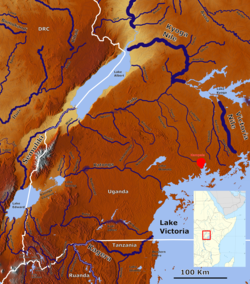| Semliki River | |
|---|---|
 | |
 Rivers of south west Uganda with the Semliki (center left). | |
| Location | |
| Countries | DR Congo (DRC) Uganda |
| Physical characteristics | |
| Source | Lake Edward |
| • location | Ishango, DRC, North Kivu Province |
| • coordinates | 00°08′25″S 29°36′04″E / 0.14028°S 29.60111°E[1] |
| • elevation | 997 m (3,271 ft)[2] |
| Mouth | Lake Albert |
• location | southeast of Bunia, DRC, Ituri Province |
• coordinates | 01°15′45″N 30°27′46″E / 1.26250°N 30.46278°E[1] |
• elevation | 619 m (2,031 ft)[2] |
| Length | 140 km (87 mi)[3] |
| Basin features | |
| Tributaries | |
| • right | River Lamia, River Ndugutu, River Nyahuka, River Kirumia |

Semliki River is a major river, 140 kilometres (87 mi) long,[3] in the Democratic Republic of the Congo (DRC) and Uganda in Central and East Africa. It flows north from Lake Edward in Beni Territory, Nord-Kivu, D.R.C avoiding the Rwenzori Mountains on its Right (East), emptying into Lake Albert in the Albertine Rift, Irumu Territory, Ituri Province, D.R.C overlooking the Blue Mountains to its left in the west. Its mouth is near the Village of Katolingo in Kanara subcounty, Ntoroko district, Uganda.[4] Along its lower reaches, it meanders extensively forming part of the international border between the DRC and the western Ugandan districts of Bundibugyo and Ntoroko, near the Semuliki National Park.[4]

Increasing snow melt from the Rwenzoris, overgrazing, and other alterations to the watershed have caused bank erosion and frequent changes to the course of the meandering lower reaches of the river.[5] In some places, Uganda is losing up to 10 metres (33 ft) of land per year on its side of the river to erosion and silt from the Semliki is gradually filling in the southern end of Lake Albert.[5] In other places, it is the DRC that is losing territory as the changing river course alters the apparent location of the border.[6]
- ^ a b Geolocation with Google Earth
- ^ a b Derived from geolocation with Google Earth.
- ^ a b "Highlights of the Uganda Atlas of Our Changing Environment, River Semliki – Lake Albert" (PDF). National Environment Management Authority (NEMA) Uganda. Retrieved 16 January 2013.
- ^ a b "Google Maps". 2013. Retrieved 17 January 2013.
- ^ a b Transboundary and Cross-Border Environmental Issues: Uganda (PDF). GRID-Arendal. pp. 138–40. Retrieved 17 January 2013.
- ^ "Changing River Course Alters Uganda-DR Congo Border". The Independent. London. 11 November 2009. Retrieved 11 November 2009.